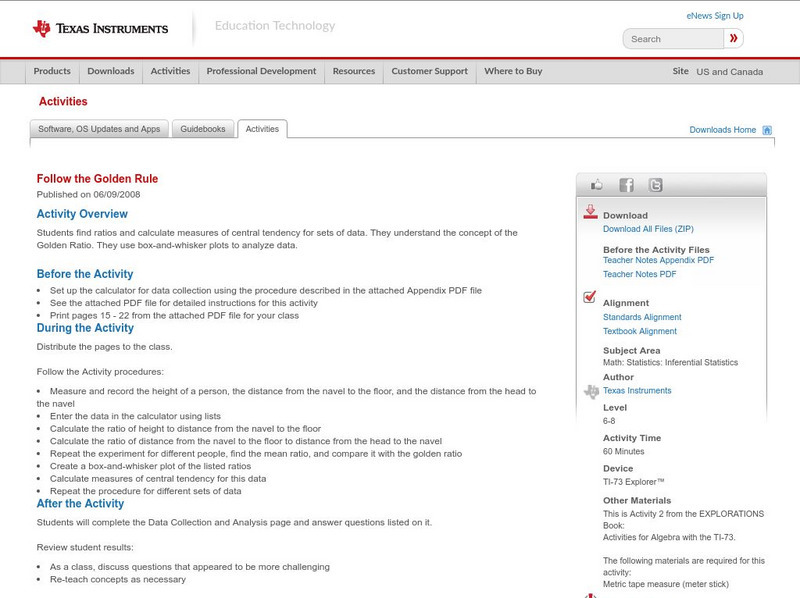Curated OER
Graphing the Daily Revenue of Miami Seaquarium
Seventh graders compile a table of the revenues of the 8 eateries (a combined total), Main Gate admissions, and the Gift Shop.
Curated OER
United States Regions
Fifth graders identify the regions of the United States. They gain general knowledge of Regions of the U.S., create a spreadsheet and use word processing to create a report.
Curated OER
Area graphics for 7th graders
Students randomly select dimensions for three geometric shapes (square, right triangle and circle). From the graphs they compare and contrast the graphical results of each shape.
Curated OER
The Derivation of (Pi)
Seventh graders groups measure the diameter and circumference of each of the circular objects in the room. They record their results on their student worksheets and access a computer spreadsheet program to compile their results.
Curated OER
Size Per Unit
Fifth graders investigate how to find the average and the concept of a per unit quantity and its applications. They also make connections of using population density and how to find the speed with its relating formula. This is bringing...
Curated OER
May We Present Planet Earth?
Students draw a map to scale. They illustrate knowledge of how to use DOGS TAILS on a map. Students identify the main parts of a map. They identify and illustrate the major features necessary for sustaining a quality of life for a society.
Curated OER
Mendellian Genetics
Students describe the inheritance patterns other than simple dominance. They are taught how Mendel's principles apply to all organisms. Students review the use of Punnett Squares. They are taught the principles of probability and...
Curated OER
Irregular Fractals
Students explore the concept of irregular fractals. For this irregular fractals lesson, students discuss how to find fractal dimensions through teacher led discussion. Students calculate fractal dimensions of various fractals.
Curated OER
Designer Babies
Students differentiate phenotypes and genotypes. In this genetics lesson plan, students complete the punnett square. They design their own baby by choosing the phenotype they want.
Curated OER
Breaking Beams
Students work together designing and building their own beams. They discover the concepts of stress and strain. They participate in a competition to determine the best beam.
US Census Bureau
Us Census Bureau: International Data Base
Statistical data on the population and demographics of 228 countries, including change, sex ratios, life expectancy, and percent with HIV/AIDS. There are also detailed explanations of the means of producing these statistics. It is...
Khan Academy
Khan Academy: The Sat Math Test: Problem Solving and Data Analysis
SAT Math questions fall into different categories; one of these domains is Problem Solving and Data Analysis. These questions might ask you to create an appropriate equation from a word problem, convert units, or understand the meaning...
University of Illinois
University of Illinois: Data Types
The University of Illinois provides this site that is helpful because of the various kinds of data that can be collected. This lesson plan helps learners differentiate between qualitative, quantitative, and many other types of data.
Other
Simple Science: Ramps and Ratios
The interactive tutorial explores ramps and ratios. Learners view and analyze images of ramps and steps to see if they conform to the requirements of the Americans with Disabilities Act. The activity has students measure vertical and...
University of Waterloo (Canada)
Centre for Education in Mathematics and Computing: Ratio and Rate [Pdf]
Learners explore the concepts of rate and ratio in a variety of problem-solving situations. Worksheets contain definitions and visual representations of concepts. Link to related ratio game. Other skills include measurement, data...
The Math League
The Math League: Ratio and Proportion
This tutorial provides definitions and examples of ratios and proportions and features comparing ratios and converting rates.
PBS
Pbs: The Lowdown: Exploring Changing Obesity Rates Through Ratios and Graphs
In these KQED Lowdown infographics, explore how adult obesity rates in the United States, as measured by body mass index (BMI), have dramatically changed in the past half-century. A circular graph and a pictograph depict data by decade,...
PBS
Pbs: The Lowdown: Living Wages in Ca: Ratio and Rate in the Real World
In this KQED infographic, find out how much an adult in different-sized households needs to make to pay for basic monthly living expenses. In the accompanying classroom activity, students solve real-life problems involving rate and ratio...
PBS
Pbs: The Lowdown: Examining California's Prison System: Real World Ratio
In this infographic from KQED, examine age, gender, and race in California's prison population to note the inconsistencies between who is in the general population and who is serving time behind bars. In the accompanying classroom...
Simon Fraser University
Chem1 Virtual Textbook: Simplest Formulas From Experimental Data
As part of the "Basic Atomics" section of the Virtual Textbook, this site a variety of topics related to simplest formulas including simplest formulas from atom ratios, simplest formulas from mass composition, and more.
Other
Ductile Iron Society: Ductile Iron Data for Design Engineers
From the Ductile Iron Society web site. Data for the elasticity and strength of ductile iron are discussed. The effect of temperature upon yield strength, elongation (i.e., strain), and ultimate tensile strength are represented in...
Texas Instruments
Texas Instruments: Follow the Golden Rule
Students find ratios and calculate measures of central tendency for sets of data. They understand the concept of the Golden Ratio. They use box-and-whisker plots to analyze data.
TeachEngineering
Teach Engineering: Car Collision Testing & Tradeoffs: Don't Crack Humpty
Student groups are provided with a generic car base on which to design a device/enclosure to protect an egg as it rolls down a ramp at increasing slopes. During this activity, student teams design, build and test their prototype...
ClassFlow
Class Flow: Pie Charts Handling Data
[Free Registration/Login Required] Students read and interpret information presented in a pie chart and then determine percentages and ratios numerically and graphically.

















